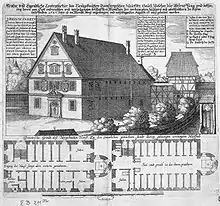Bamberg witch trials
The Bamberg witch trials, which took place in Bamberg in 1626–1631, were one of a series of mass witch trials in southern Germany, contemporary with the Würzburg witch trials and others. Over an extended period these trial resulted in the executions of around 1,000 people. It belonged to the largest witch trials in history, among the largest during the Thirty Years' War, and one of the four largest witch trials in Germany alongside the Trier witch trials, the Fulda witch trials, and the Würzburg witch trial.[1]


History
Background
In the late 16th and early 17th centuries, the Holy Roman Empire was affected by a Little Ice Age that resulted in a drop in temperatures and crop failures. This caused the rural poor to look for a responsible party. They found it in witches - people who had supposedly allied themselves with the devil.[2]
Prince-Bishop of Bamberg Neytard von Thüngen (d. 1598) was the first to allow witch trials in his diocese. However, he was mostly occupied with fighting Reformation. Under his successor, Johann Philipp von Gebsattel (d. 1609) no one was executed for witchcraft. Only under Johann Gottfried von Aschhausen (d. 1622), did prosecutions take off. Supported by the theologian Friedrich Förner, the bishop allowed a trial to go ahead that grew out of a family quarrel. In its course, several other people were charged with witchcraft and within one year 15 had been executed.[2]
An even more murderous round of prosecution came in 1616 after a series of crop failures. Through 1622 a total of 159 trials were registered, most resulting in deaths. Under chancellor Georg Haan, the trials then subsided.[2]
Witch trials of 1626-1632
The most intense period followed under Prince-Bishop Johann Georg Fuchs von Dornheim in 1626. After a devastating night frost that severely damaged the crops, the witch trials resumed. To preserve fire wood, a large crematorium was built at Zeil am Main, the centre of the executions. At Bamberg, a special prison was erected to house the masses of suspects, the Malefizhaus. In 1628, the craze peaked with almost 200 documented trials. Georg Haan was among those who were burned. Johannes Junius, whose testimony of the torture he underwent become famous, was another, as was his wife.[2][3]
However, support among the population began to fade as people increasingly realized that everybody was at risk of ending up on the pyre. Peasants refused to supply wood for the burnings. The final straw came with the trial of Dorothea Flock, member of a well-off merchant family from Nuremberg. She was arrested in December 1629 and her husband did everything he could to obtain her release. An Imperial edict was issued by the Hofrat, but the witch hunters learned about its imminent delivery and executed Dorothea shortly before its arrival. This caused outrage among the leadership of the Catholic church in Germany, who held the bishop responsible. An investigation by the Hofrat prevented any further trials from being launched.[2]
End and aftermath
They ended for good when the Protestant Swedish troops approached Bamberg in 1632. The remaining prisoners were released. The bishop fled to Austria.[2]
Several more witch trials followed until 1680. By that time, a total of around 1,000 people had been killed in the Prince-Bishopric of Bamberg.[2]
References
- Midelfort, H. C. Erik, Witch hunting in southwestern Germany 1562-1684: the social and intellectual foundations, U.P, Stanford, Calif, 1972
- Munzinger, Johannes (1 May 2016). "Unschuldig muss ich sterben (German)". Frankfurter Allgemeine Zeitung. p. 4.
- Walinski-Kiehl, Robert (January 2004). "Males, "Masculine Honor," and Witch Hunting in Seventeenth-Century Germany". Men and Masculinities. 6 (3): 257.
- Hugh Trevor-Roper: The Crisis of the Seventeenth Century. The European Witch-craze of the Sixteenth and Seventeenth Centuries (1967)
- "The European Witch-craze of the Sixteenth and Seventeenth Centuries".